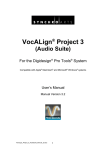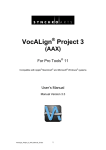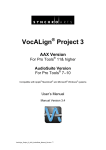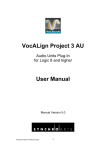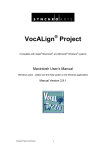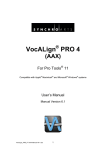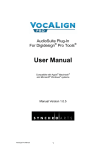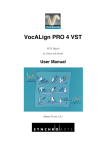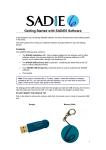Download VocALign Project LE for the Digidesign
Transcript
® VocALign Project LE For the Digidesign® Pro Tools® System Compatible with Apple® Macintosh® and Microsoft® Windows® systems User’s Manual Manual Version 2.9 LE VocALign_Project_PT_LE.doc 1 © Synchro Arts Limited 1995-2003 VocALign is a registered trademark of Synchro Arts Limited. Pro Tools and Digidesign are registered trademarks of Digidesign, a Division of Avid Technology, Inc. All other trademarks are the property of their respective holders. Contact Information Synchro Arts Limited 13 Links Road Epsom Surrey KT17 3PP Tel: +44 1372 811934 UK Tel: 01372 811934 Fax: +44 1372 817976 UK Fax: 01372 817976 Web: www.SynchroArts.com E-mail: [email protected] Online Support at: www.SynchroArts.com/support VocALign_Project_PT_LE.doc 2 End User License Agreement PLEASE READ THE FOLLOWING LEGAL AGREEMENT CAREFULLY PRIOR TO USING THE VOCALIGN SOFTWARE PROVIDED WITH THIS AGREEMENT. USE OF THE SOFTWARE CONSTITUTES YOUR ACCEPTANCE OF THE TERMS OF THIS LICENSE. IF YOU DO NOT AGREE TO THE TERMS OF THIS LICENSE, YOU MAY NOT USE THIS SOFTWARE. 1. License. The application, demonstration and other software and audio accompanying this License, whether on disc, in memory or on any other media (the "Software"), and the related documentation are licensed to you by Synchro Arts Limited. You may use the Software on a single computer, make one copy of the Software for backup purposes only and physically transfer the Software from one computer to another provided that the Software is only used on one computer at a time. You may also transfer all your license rights in the Software, the backup copy of the Software, the related documentation and a copy of this License to another party, provided the other party reads and agrees to accept the terms and conditions of this License. 2. Copy and use restrictions. You are not allowed to distribute copies of the Software or the documentation. This Software is protected by the copyright laws that pertain to computer software. It is illegal to make copies of the Software, except for backups. It is illegal to give copies to another person, or to duplicate the Software by any other means, including electronic transmission. The Software contains trade secrets and in order to protect them you may not decompile, reverse engineer, disassemble or otherwise reduce the software to human-perceivable form. You may not modify, adapt, translate, rent, lease or create derivative works based upon the Software or any part thereof. You may not provide use of the Software in a network, time-sharing, or multiple user arrangement. You acknowledge that no title to the intellectual property in the Software is transferred to you and that title and full ownership rights to the Software a will remain the exclusive property of Synchro Arts Limited or its suppliers and licensors. 3. Termination. This License is effective until terminated. You may terminate this License at any time by destroying all copies and recordings of the licensed software and documentation and giving a legally binding written assurance to Synchro Arts that you have done so. This License will terminate immediately without notice from Synchro Arts Limited if you fail to comply with any provision of this License. Upon termination you must destroy all copies and recordings of the Software, related documentation and copies thereof and return to Synchro Arts the originals of the Software and documentation. 4. Limited Warranty. Synchro Arts Limited and Digidesign warrant that the original disc (if supplied) on which the Software is recorded is free from defects in materials and workmanship, assuming normal use, for a period of ninety (90) days from the date of purchase. If a defect occurs during this period, you may return your faulty disc to Digidesign along with a dated proof of purchase and Digidesign will replace it free of charge. This limited warranty is void if failure of the Software has resulted from accident, abuse or misapplication. Any replacement Software will be warranted for the remainder of the original warranty period. This warranty gives you specific legal rights and you may also have other rights which vary by jurisdiction. 5. No Other Warranties. EXCEPT FOR THE EXPRESS WARRANTY OF THE ORIGINAL DISCS SET FORTH ABOVE, SYNCHRO ARTS LIMITED GRANTS NO OTHER WARRANTIES, EXPRESS OR IMPLIED, BY STATUTE OR OTHERWISE, REGARDING THE DISCS AND RELATED MATERIALS, THEIR FITNESS FOR ANY PURPOSE, THEIR QUALITY, THEIR MERCHANTABILITY OR OTHERWISE. THE LIABILITY OF SYNCHRO ARTS LIMITED UNDER THE WARRANTY SET FORTH ABOVE SHALL BE LIMITED TO THE AMOUNT PAID BY THE CUSTOMER FOR THE PRODUCT. IN NO EVENT SHALL SYNCHRO ARTS LIMITED OR ITS AUTHORIZED DISTRIBUTORS BE LIABLE FOR ANY SPECIAL, CONSEQUENTIAL OR OTHER DAMAGES OR BREACH OF WARRANTY. 6. Severability. In the event any provision of this Agreement is determined to be invalid or unenforceable, it shall be adjusted so as to best reflect the intent of the parties to the maximum extent possible, and the remainder of this agreement shall be valid and enforceable to the maximum extent possible. 7. Entire Agreement. This Agreement is the entire understanding between the parties with respect to the subject matter hereof and replaces any previous discussion and/or agreement regarding such subject matter. No amendment to or modification of this License will be binding unless in writing and signed by Synchro Arts Limited. 8. Governing Law. This Agreement shall be interpreted and enforced in accordance with English law and the English courts shall have jurisdiction to determine any dispute. VocALign_Project_PT_LE.doc 3 Table of Contents. END USER LICENSE AGREEMENT ............................................................. 3 A) IMPORTANT NOTES............................................................................. 5 B) INTRODUCTION TO VOCALIGN .......................................................... 6 C) APPLICATIONS..................................................................................... 7 D) UNLOCKING AND DEACTIVATION ..................................................... 8 E) QUICK START GUIDE ............................................................................. 8 F) OPERATIONAL GUIDE.......................................................................... 10 Screen and Controls ........................................................................ 10 Normal Operation: ........................................................................ 1112 Altering the Selected Region....................................................... 1415 Moving the Dub Display for Inspection ...................................... 1516 Processing Signals with Different Lengths................................ 1516 Aligning Multiple Takes................................................................ 1718 Foreign Dialogue Synchronization ............................................. 1819 Special Operations:...................................................................... 2021 G) TROUBLE-SHOOTING.................................................................... 2122 VocALign_Project_PT_LE.doc 4 A) Important Notes This program is compatible with Pro Tools 6.0 LE (or higher) software on Mac OS X and Windows XP. VocALign Project LE for the Digidesign Pro Tools system processes audio with sample rates up to 192 kHz. In this manual, "VocALign Project LE, for the Digidesign Pro Tools System" will be referred to as "VocALign Project LE" Acknowledgements Special thanks to the Digidesign staff for their continued support. Thanks also to Steve Cooke for providing all voices in the demonstration audio. VocALign is developed and sold under license from Wordfit Limited. VocALign_Project_PT_LE.doc 5 B) Introduction to VocALign What is VocALign? VocALign is a process that lets audio editors make the timing of one audio signal match another automatically. How does VocALign work? VocALign works by applying varying amounts of time stretching or compression to one signal (called the "dub") to make its energy peaks and troughs align in time with a “guide” signal. This alignment is fast and of the highest quality. What can VocALign do for me? If you are a dialogue editor needing to lip-sync vocals, or a music editor needing to tighten-up lead or backing vocals, instrumental tracks, or a number of other alignment tasks, then VocALign is for you! Consider the following examples: Working without VocALign: A dubbing session, for film post production, or music production, begins with a guide track. Then the voice-over artist, singer, or musician will dub this as closely as possible. Because humans are not machines, they will not be able to get exactly in time with the guide. This is generally not acceptable for lip-syncing, nor for double-tracking of vocals or instruments. Often, the next step is to loop-record the more tricky sections individually, but this can break-up the natural flow of the line. Lastly, the editor will use a digital audio editor to cut and nudge individual sections into time with the guide. The above process can take many hours for both the artist and the editor. Above all, the process sometimes creates a result that is inferior in quality. Working with VocALign: The above process becomes a simple matter of getting the artist to concentrate on creating a great performance, and not worry about the fact that it may drift in and out of exact sync with a previous performance. VocALign can then be used to adjust the timing by automatically applying the required amount of varying time-stretching and compression to allow the dub to take on the same timing as the guide. This saves studio time, saves artists time and improves the quality of your results. Most importantly, you allow your artists to produce their best performances, free from the rigidity normally associated with dubbing. VocALign_Project_PT_LE.doc 6 C) Applications VocALign was originally designed for Lip Syncing replacement dialogue for Film and Video post-production but it has been adapted to work successfully in all of the following applications: • Syncing replacement dialogue in Post Production for Film and Video. • Double-tracking vocal parts or instrumental parts • Tightening backing singers with one another, or with the lead vocal • Tightening backing instrumental tracks • Sync’ing a drum machine audio-output to a real drummer (or vice versa) • Giving a dubbed vocal the timing of a “live” vocal performance, • Changing the voice or even sex of a singer or actor’s performance. • Replacing the vocals in a music video shoot with a production track, achieving perfect lip-sync. • Foreign Language Dubbing VocALign_Project_PT_LE.doc 7 D) Unlocking and Deactivation This version of VocALign uses iLok. Please see the accompanying Digidesign documents for information about authorisation of Audio Suite Plug-ins or visit www.ilok.com. E) Quick Start Guide To learn to use VocALign Project LE only takes a few minutes, but for getting the best results we strongly recommend that you first try VocALign Project LE on the "VocALign Tutorial PT" Session. The "VocALign Tutorial PT" session can be found in the "Tutorial" folder on the install CD (if you have one), or can be downloaded from: www.synchroarts.com/downloads Next, open the “VocALign Tutorial PT" session in Pro Tools. (Alternatively have your own suitable session loaded.) The operation of VocALign Project LE is simple: you select and capture your Guide and Dub audio, align the Dub to the timing of the Guide, and send the Aligned audio back to Pro Tools. The VocALign Project LE Window: 1. Select the VocALign Project LE Plug-in from the AudioSuite menu in Pro Tools. 2. Make sure “use in playlist” is selected 3. Select the Guide audio in Pro Tools (e.g. Steve Guide 2 in the "VocALign Tutorial PT" session) 4. In VocALign Project LE, click the Guide button or panel and then press Capture. The Guide audio energy profile will appear in the Guide Panel. VocALign_Project_PT_LE.doc 8 5. Select the Dub audio in your audio editor (Twit-Dub in the Example Session) 6. In VocALign Project LE, select the Dub panel and press Capture. The Dub audio energy profile will appear in the Dub Panel. 7. Make sure Normal Flexibility appears in the Settings Window. If it doesn't, press Settings Selector "3". 8. Press Align to generate an Aligned Dub trace that lets you visually check alignment. 9. Select a destination track for the Aligned audio. (e.g. select Audio 3 for the "VocALign Tutorial PT" Session 10. Press Process. The Aligned audio will be sent to the selected destination track in your audio editor. 11. In Pro Tools, play the Guide and Aligned audio regions with the Dub track muted. The Aligned audio will have its timing corrected to match the Guide. Note - it is recommended that you DO NOT "Save" the Pro Tools' "VocALign Tutorial PT" session when exiting Pro Tools, so it can be used again. Consult the information in Chapter G: “Troubleshooting” if the audio you have aligned does not appear to be aligned properly. Chapter F details how to get the most out of VocALign Project LE. VocALign_Project_PT_LE.doc 9 F) Operational Guide Screen and Controls Description of Controls: 1) 2) 3) 4) 5) 6) Guide Button and Panel: Click on this to select Guide for input from Pro Tools. Align Button: Click this to generate the Aligned audio trace. Dub Button and Panel: Click on this to select Dub for input from Pro Tools. VocALign Button: Access to the Manual. Preview Button: Click to audition the new Aligned audio. VocALign Settings: Control the way that VocALign aligns the audio: 1) Maximum Compression: Tries to match the Guide by time compressing the aligned audio as much as possible 2) Low Flexibility: Alignment is not very flexible, sound quality may be best. 3) Normal Flexibility (Default): Standard VocALign settings, works best in most cases 4) High Flexibility: Alignment is as flexible as possible 5) Maximum Expansion: Tries to match the Guide by time-expanding the aligned audio as much as possible 7) Capture Button: Click to transfer the selected audio from Pro Tools to the Guide or Dub panels. 8) Process Button: Creates the Aligned audio and places it in the destination track in sync with the Guide audio. 9) Guide Energy: A profile of the energy of the Guide signal in time 10) Dub Energy: A profile of the energy of the Dub signal in time 11) Aligned Audio Trace: A representation of the energy of the new Aligned signal. 12) Scaling and scrolling controls: Click to adjust how VocALign displays the Guide and Dub energy signals. • Zoom in and out with the + and – buttons • Scroll left and right with the < and > buttons 13) Destination Track: Selects into which Pro Tools track the Aligned audio will be placed when Process is pressed. It is advised that you always select a destination track. (See “Special Operations” later in this chapter.) 14) “Use In Playlist” button: It is advised that you always select this option VocALign_Project_PT_LE.doc 10 Normal Operation: 1) In Pro Tools, open a session in which there is "Guide" (original) audio contained in a single Pro Tools Region on one track and a "Dub" (replacement or new) audio in a second track. Ensure that at least a third track is available and visible in Pro Tools to receive the processed. 2) Highlight the desired portion of the Guide audio region for processing. This can be any given region or multiple regions. Your selection can begin and end in the middle of a region. TIP: Try to capture up to around 0.25 to 0.5 seconds of “background” or “leader” audio at the beginning of your Guide audio selection. (This will assist the process to set the noise floor levels and generally allow better alignment at the start of the signal). Note: In the current version of VocALign Project LE, the selected audio must be shorter than 120 seconds and longer than 0.25 seconds. 3) Select “VocALign Project LE” from the AudioSuite menu in Pro Tools. Click on the Guide button or panel, and then click the Capture button. 4) Using the Selector Tool in Pro Tools, highlight the desired portion of the Replacement audio region or Dub for processing. Again, this can be any given region or multiple regions. Your selection can begin and end in the middle of a region. TIP: Try to capture very slightly more “background” audio before the Dub signal starts than you did for the Guide. 5) In VocALign Project LE, click on the Dub button or panel, and click the Capture button VocALign_Project_PT_LE.doc 11 6) Examine the non-processed alignment shown in the energy profiles. 7) The user can optionally perform several operations on the audio waveform itself before processing. He can extend or shorten the selected regions by positioning the cursor (arrow) at either end of the audio selections: This indicates that by holding down the mouse button, the active region boundary can be moved right or left by moving the mouse left or right. This is an important operation for selecting the right amount of audio at the start and end of the signals. 8) In addition, the user can scroll the display with the scroll bars to examine the captured waveforms. 9) The Scale - and + buttons can be used to zoom in or out of the waveform to see more (+) or less (-) detail in the display windows at one time. 10) Choose an appropriate setting (e.g. if the Dub is very long compared to the Guide, try "Maximum Compression", setting number 1.) 11) Click on Align and examine the results visually. The preview button allows you to hear the Aligned signal on its own. 12) If the alignment is satisfactory, select the destination track and press Process. • If the alignment does not look satisfactory, there are two main options: a) Select another Setting (which will clear the aligned trace), press Align again, and examine the results. VocALign_Project_PT_LE.doc 12 b) Adjust the "leader" audio before the start of the Guide audio to be roughly equivalent with the Dub "leader" being somewhat longer. See below. Important: The Dub does not have to start at the time of the Guide. In other words, its timecode position is not used. The Guide's timecode is important and so is the amount of “background” captured before the Guide and the Dub. 13) The user can re-capture the Guide or Dub individually at any time and replace any previous settings. VocALign_Project_PT_LE.doc 13 Altering the Selected Region We will next reduce the length of the Dub being processed without having to return to Pro Tools. You may wish to do this to align only the beginning part of the dub and leave the following part unaligned. 1) First, move the cursor to the end of the Dub filtered as shown below. 2) Next, hold down the mouse button, and a dotted line should appear. While holding down the mouse button, drag the line to the left and release it at the point shown in the next picture. (This does not need to be exactly the same point). 3) The above picture indicates that the selected Dub region for processing is now much shorter than the Guide selected region. 4) Click on Align and the following result should appear: The Selected Dub audio has been aligned to the corresponding section of the Guide. 5) Pressing the Preview button will audition the Aligned audio. 6) Select “Audio 4” as the destination track, and click Process. 7) In Pro Tools, play the resulting track “Audio 4” with “Audio 1”. VocALign_Project_PT_LE.doc 14 Moving the Dub Display for Inspection Before or after Alignment takes place, if mouse pointer is placed over the Dub energy display and the mouse button clicked, an Open Hand Icon will appear: By holding down the mouse button, the Hand Icon will appear "closed" and the Dub audio or Filtered output display can be "dragged" back or forth to check the alignment visually. This has no effect on processing. Processing Signals with Different Lengths In general, it is common for either the Guide or Dub to be part of a much longer audio regions than the other is. In most cases, the Guide region is longer (being part of a long transfer), while the Dub is a shorter section. In the second example in the Demo Session, however, we have a Dub that is much longer than the Guide, and even contains extra audio at the end of the region that is not in the Guide. 1) Open the VocALign Tutorial PT session. Make sure that the second set of audio regions is visible. 2) The Guide (Steve Guide2) and Dub (Twit-Dub) should be played together to hear how the Dub is not only much slower and longer than the Guide but it has extra audio at the end. 3) Highlight the Guide audio as shown below and Capture it in VocALign by clicking on the Guide button, and clicking on Capture. 4) Next, highlight the entire Dub as shown below, and capture it into VocALign by clicking on the Dub button, and clicking on Capture. VocALign_Project_PT_LE.doc 15 The user could chose to stop before the last part of the audio, but this example will show that when the highlighted Guide region stops, if there is more Dub selected to process, it will simply be added on after the alignment activity required by the Guide is completed. 5) The following should appear:- Before processing, the user should try to determine which modulations in the Guide match with modulation in the Dub. 6) Next, click on the Align button and the resulting aligned (orange) trace over the Guide should appear as shown below: In this case, the Dub audio filter waveform is aligned up to the point where the Guide selected waveform (shown in blue) stops, and then the rest of the Dub filter waveform is joined on but without any modification. 7) The user should ensure that the Setting shows Normal Flexibility and that the track “Audio 3” is selected as the destination track, and then click Process. VocALign should generate the Aligned audio and then “spot” it into Pro Tools. 8) Play the result in Pro Tools and note the amount of time compression required to align these two signals and also note how the end of the Aligned Dub is unedited. VocALign_Project_PT_LE.doc 16 Aligning Multiple Takes One further useful feature of VocALign Project LE is that once a Guide or Dub is captured, you may recapture one of the signals without affecting the other. There are many advantages to this, and in this last Example, we will use this feature to align three different vocal tracks. 1) Return to the Pro Tools VocALign Tutorial PT session and locate the three regions shown below and highlight the audio within the region "BG-Guide1" in track “Audio 1” as shown. Capture this as the Guide. You should also play these three tracks together to hear how they are aligned in this session. Next, carry out the following steps carefully: 2) In Pro Tools, highlight and capture the BG-Voice2 region as shown below as the Dub. 3) Align this using Normal Flexibility, examine the sync and if it looks correct, set the destination track to “Audio 4” and click Process. The edited region should appear in Pro Tools track “Audio 4”. 4) Next, highlight and capture the BG-Voice3 region as shown below as the Dub. 5) Change the VocALign Project LE Setting to Low Flexibility (setting number 2). This is to minimize the amount of editing on this voice. 6) Next, click Align and examine the alignment. Set the destination track to “Audio 5” and click Process. The edited region should appear in Pro Tools track “Audio 5”. 7) In Pro Tools, mute tracks “Audio 2” and “Audio 3”, and play tracks “Audio 1”, “Audio 4“ and “Audio 5” together. They should be tightly synchronized. VocALign_Project_PT_LE.doc 17 Foreign Dialogue Synchronization Summary This section discusses the problems that arise in foreign language dialogue replacement (dubbing) and how and when VocALign can be used to assist this process. Overview The quality of lip synch that can be achieved in Foreign Dialogue Replacement (often called Dubbing, Doublage, etc.) depends on many factors including:• The quality of the translation. • The accuracy of the timing of the new dialogue recording. • The ability of the editor to modify the new dialogue. VocALign will attempt to align one set of audio modulations to another, no matter what the audio signals are. Therefore, it can be used to align the modulations of recorded dialogue in one language to recorded dialogue in another language. Thus, when there is an audio Guide Track that is in good synch with the lip movements in the picture, VocALign can generally be used to improve the accuracy of the lip sync of the replacement foreign dialogue. Sometimes, unfortunately, the Guide Track will not be in close sync with the picture. This can occur if the Guide Track is itself already badly dubbed or in a different language from the original location recording. In this case, even if VocALign matches the new audio modulations to the Guide, they will be out of sync, just as the Guide is. An experienced editor must align the audio by ear and eye in this case, and VocALign is not likely to be of much assistance. Also, the Guide track used for dubbing can sometimes contain music and effects. This makes the job for VocALign harder, but not impossible, since it must "ignore" the music and effects in the Guide Track and match only to the dialogue. Lastly, the translation may demand that the two audio signals are vastly incompatible and result could never be totally satisfactory. In this case, the best result sometimes comes from making the two audio signals start together and, if possible, end together. VocALign or the use of linear time compression or expansion products (such as Synchro Arts TimeModTM) can often help in this case, too. Suggested Operations Advice: Dialogue Editors should be very familiar with the use of VocALign on dialogue replacement in the same language before attempting to use it for foreign dialogue replacement. VocALign_Project_PT_LE.doc 18 The following tips are suggestions and not rules, so the user should not only try these techniques, but also experiment further. Every line of dialogue is likely to need individual attention. When to use VocALign If the Guide Track dialogue is in sync with the picture, and the replacement foreign dialogue has been translated and recorded to achieve good lip sync, then VocALign should be able to improve the quality of lip sync. Break the dialogue into appropriate length sections. The user must remember that VocALign is deliberately restricted to stretching a part of a signal by a factor of 2.0 (100% expansion) and compressing it by a factor of 1/2 (50% compression). If VocALign is trying to expand or compress a gap in the speech, and it has used up its allowance, it may try to expand or compress the neighbouring speech. This means, for example, that if gaps in the new and replacement dialogue appear in different places or are of very different durations, after modifying the gap region, VocALign might also have to expand or compress the replacement speech signal near the gap, to best align the modulations. This may lead to unwanted effects. In this case, the user should break the signal into sections that can be individually treated. Sync up only the beginning of a line To get only the beginning of a new line of dialogue to sync up with the Guide, use the "latching" technique described earlier. This means only selecting perhaps a second at the start of the guide that VocALign will try to sync the dub start to, and the entire replacement line for the dub. Minimize the amount of VocALign's Time Compression and Expansion If VocALign is making too many timing modifications and creating unnatural sounding speech, try using the "Low Flexibility" setting. To align only the start and end of the replacement audio Use a Linear Time Compression/Expansion utility (such as TimeMod™ available with VocALign Pro and ToolBelt from Synchro Arts) to get the new dialogue to the same length. Then use VocALign to fine tune it. Use combinations of original and VocALigned output By using the Process feature of VocALign in conjunction with the Copy functions of Pro Tools, a mixture of VocALign output and the original signal is sometimes the best way to achieve a balance between synchronized and natural sounding speech. VocALign_Project_PT_LE.doc 19 Special Operations: “Latching” To align just the start of the Dub with the Guide (and leave the rest of the Dub unprocessed), capture only 0.25 to 1.0 second of the Guide and capture the Dub as normal. Reverb tails To stop the end of a Dub from being stretched to wrongly "fit" to a noisy or reverberant Guide, stop the captured end of the Guide 0.25 to 1.0 second before the Guide signal of interest ends and capture the Dub as normal. Destination Track set to “none” Normally, the VocALign Project LE user is advised to always select a “destination track” in the plug-in. However, if the destination track is set to “none” and aligned audio is “processed”, it will be returned to Pro Tools in sync with the original guide audio, and on a track where the cursor is present. Once aware of this fact, the VocALign Project LEuser can make use of it to speed-up the operations involved in using VocALign Project LE: 1) 2) 3) 4) Make sure “use in playlist” is selected Ensure that the Dub audio is close to the Guide audio in the Pro Tools timeline. Select the Guide audio and send it, as normal, to VocALign Project LE Select the Dub audio and send it to VocALign Project LE, making sure the Dub audio remains highlighted. 5) Once aligned, press “Process” with “destination track” set to “none”. The aligned audio will be sent to the track where the Dub was taken from. In this way, dub audio can be aligned by VocALign Project LE and updated in Pro Tools. There is then no need for an additional track to receive the “aligned” audio. VocALign_Project_PT_LE.doc 20 G) Trouble-Shooting Some commonly occurring problems are listed here: Problem: “VocALign Project LE does not appear in the AudioSuite menu.” Solution: Mac users: Check that the file "VocALign Audiosuite" has been copied to the Plug-Ins folder within the DAE folder in your “System Folder”. Windows users: Check that the files "VocALignLE.dpm" and "VocALignLE.dpm.rsr" have been copied to the Plug-Ins folder within the DAE folder. Problem: “The aligned audio appears in an incorrect destination track.” Solution: Make sure you have selected a destination track before pressing “Process”. If “none” is the selected destination track, the aligned audio will appear in the currently selected track, in sync with the Guide. If you have renamed Pro Tools tracks whilst the plug-in window is open, the drop-down destination track list will not reflect those changes until the plug-in window is closed and opened again. Problem: “No aligned audio appears in the audio editor”. Solution: Make sure you have selected “use in playlist” in the VocALign Project LE window. Further help and advice can be found on the Synchro Arts website at http://www.SynchroArts.com/support VocALign_Project_PT_LE.doc 21





















